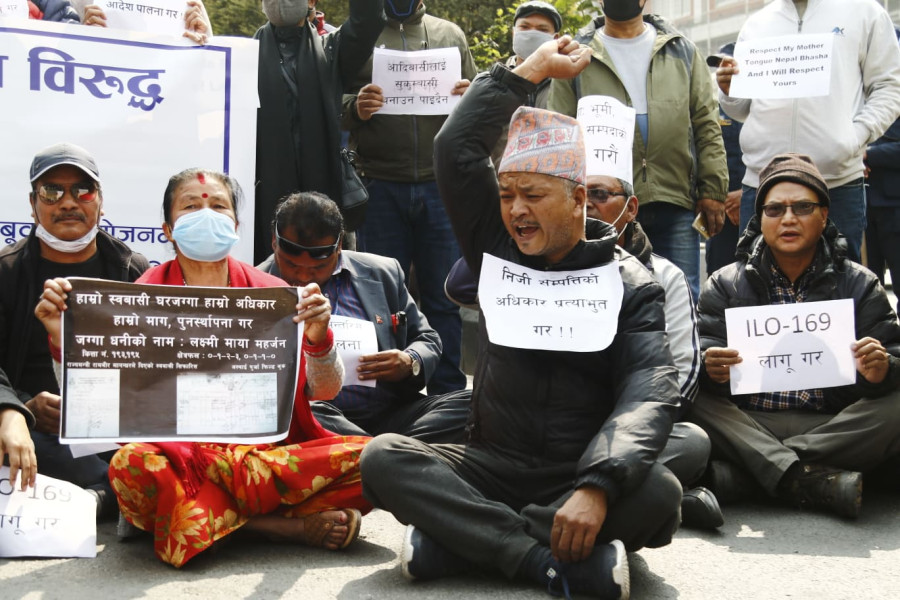Valley
Memories of house demolition haunt us every day, Balaju Bypass residents say
Eviction of 39 families has left deep mental scars on members of Newa community.
Anup Ojha
When Bhimdev Shrestha and his seven friends were arrested in Balaju for protesting against a road-widening drive, his mother 97-year-old Sanumaya Shrestha was bedridden.
Bhimdev, one of the victims of the government’s road-widening campaign at Balaju, Bypass, was released this week. But the bulldozing of houses in his neighbourhood has left deep mental scars on its residents, including Sanumaya, who can’t speak.
“It’s been a year since my grandmother lost her speech,” said Suman, son of 42-year-old Bhimdev. “As she was on the balcony on the second floor of our two-and-half-storey house when the government started demolishing the house,” he added. “She has been ill for the past four years now...she cries every time she remembers the demolition,” said Bhimdev.
Bhimdev’s is one of the 39 families from the indigenous Newa community that were living in Balaju Bypass before they were forcefully evicted by the Kathmandu Valley Development Authority in 2016.
Amid widespread criticism from locals and heritage activists from the Brihat Nagarik Andolan, the Supreme Court on Tuesday released all eight local residents detained by police for protesting against the widening of the road.
“Even though my father and others are released, the government has forcefully snatched our ancestral property and the memories of the demolition will forever haunt us,” said Bhimdev, who joined Tuesday’s programme to light candles in Indra Chowk against the government’s encroachment upon Newa land and suppression of their culture.
Ever since the authority demolished Bhimdev’s house, his family of eight—grandmother, father, mother, two children, brother, and wife—has been living in a rented room in Machhapokhari.
“You know how painful it is to stay in a rented house and become landless,” said Shrestha.
Shrestha’s house was built on three-and-a-half aana (1,200 sq ft) of land. He said he has all documents including water and electricity bills to prove that the land belongs to his family.
Authorities say that the houses had to be demolished as the road next to them was widened to 14 metres. But local residents complain that even houses beyond the 14-metre mark were demolished.
“Earlier the authority had said that property within 1.5 meter of the road would be demolished. I personally spent Rs1.8 million to bring down a section of my house to comply,” said Bhimdev. “But officials demolished my house and paid me just Rs318,000,” he told the Post. “Is it justice?”
Residents of Bypass had filed a writ petition against the government’s decision at the Patan Appellate Court in 2016. On March 21, 2017, the Supreme Court had ordered the Kathmandu Metropolitan City not to start the road expansion work until the issue with the local was settled. However defying the court order, the city again bulldozed the area to construct an information center for which it has allocated Rs 10 million.
“I have nowhere to go. Even when the Supreme Court asked the authority not to carry any work, they evicted us forcefully,” said Aashmya Khadgi, 61, another local resident from Bypass.
“This is the land where we were raised and I am over 60 now, we have all the required documents to prove that this land belongs to us. The city is forcefully trying to make us landless,” said Khadgi, speaking at a protest in front of the Kathmandu Metropolitan City’s office.
During the past week, there have been regular protests organised by locals of Balaju and the larger citizen group demanding the government return seized land.
“Kathmandu Metropolitan City allocated Rs 10 billion to construct an information office despite the court's stay order. It shows how insensitive the mayor has become to the Newa community’s problems in Balaju Bypass,” said Rabindra Kumar Shrestha, chairman of Progressive Civil Society.
“The road has been expanded only on one side under the influence of some politically connected people. This has forcefully displaced the old settlements,” said Bhimdev.
Ganapati Lal Shrestha, a youth conservationist accuses the Kathmandu Metropolitan City of taking on a destructive attitude rather than conserving historic heritage sites such as Rani Pokhari, Kamal Pokhari, and Newa settlements.
“We assumed that it was difficult for the state to conserve century-old cultural and heritage of Kathmandu in the absence of local representatives, but when Mayor Shakya came to office, all he has done is damage our heritage properties though he belongs to the Newa community,” said Shrestha.
Meanwhile, Rajendra Maharjan, one of the active activists of Brihat Nagarik Andolan said they had been taking part in the protest ever since local residents were arrested last week. “It has been years since the authority forcefully suppressed the local voices. Even the media didn’t pay much attention to it. Now we are fighting to guarantee their rights,” said Maharjan.
Maharjan also accused the government of destroying culture and language in the name of development. “We are taking forward our protest against regression in the authority,” said Maharjan.
Suman, the grandson of the ailing nonagenarian Sanumaya said that the family had been living in its house in Bypass for over 70 years. “I am sure, my grandmother would feel better only if she hears that our seized land has been returned. But the government won’t listen,” said Suman.




 7.15°C Kathmandu
7.15°C Kathmandu.jpg)









%20(1).jpg&w=300&height=200)

